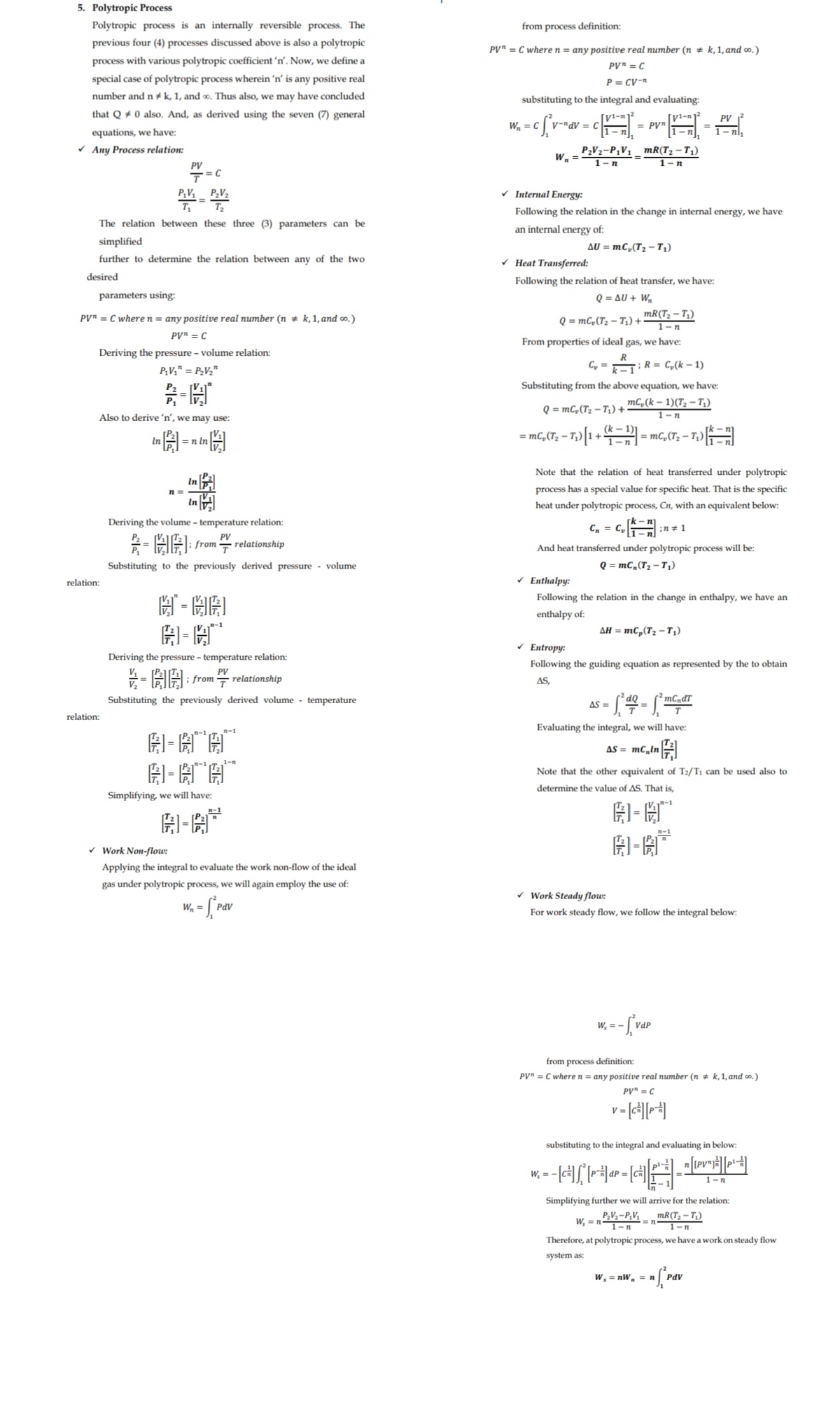seven general property equation of the following thermodynamics processes: a. POLYTROPIC
seven general property equation of the following thermodynamics processes: a. POLYTROPIC
Elements Of Electromagnetics
7th Edition
ISBN:9780190698614
Author:Sadiku, Matthew N. O.
Publisher:Sadiku, Matthew N. O.
ChapterMA: Math Assessment
Section: Chapter Questions
Problem 1.1MA
Related questions
Concept explainers
Heat Exchangers
Heat exchangers are the types of equipment that are primarily employed to transfer the thermal energy from one fluid to another, provided that one of the fluids should be at a higher thermal energy content than the other fluid.
Heat Exchanger
The heat exchanger is a combination of two words ''Heat'' and ''Exchanger''. It is a mechanical device that is used to exchange heat energy between two fluids.
Question
Derive the seven general property equation of the following
a. POLYTROPIC PROCESS

Transcribed Image Text:5. Polytropic Process
Polytropic process is an internally reversible process. The
from process definition:
previous four (4) processes discussed above is also a polytropic
PV" = C where n = any positive real number (n # k,1, and ∞.)
PV" = C
P = CV-"
process with various polytropic coefficient 'n'. Now, we define a
special case of polytropic process wherein ´n' is any positive real
number and n + k, 1, and . Thus also, we may have concluded
substituting to the integral and evaluating:
that Q + 0 also. And, as derived using the seven (7) general
A-
[V1-n
PV
= C
V-"dV = C
= PVn
equations, we have:
- n
v Any Process relation:
P2V2-P¡V1 _ mR(T2 – T1)
Wn =
1-n
1-n
PV
= C
P;V _ P¿V2
T2
Internal Energy:
=
Following the relation in the change in internal energy, we have
The relation between these three (3) parameters can be
an internal energy of:
simplified
AU = mC,(T2 – T1)
further to determine the relation between any of the two
v Heat Transferred:
desired
Following the relation of heat transfer, we have:
parameters using:
Q = AU + W,
mR(T2 – T,)
PV" = C where n = any positive real number (n # k,1, and co.)
Q = mC,(T2 – T;) +
1-n
PV™ = C
From properties of ideal gas, we have:
Deriving the pressure - volume relation:
P,V," = P,V2"
Cy
k -
; R = C„(k – 1)
一
Substituting from the above equation, we have:
mC, (k – 1)(T2 – T,)
Q = mC,(T2 – T1) +
Also to derive 'n', we may use:
1-n
(k -
= mc,(T, – T,) 1 + = mC,(T, – T,)
In
=n In
1-n
Note that the relation of heat transferred under polytropic
In
process has a special value for specific heat. That is the specific
In
heat under polytropic process, Cn, with an equivalent below:
Deriving the volume – temperature relation:
Cn = C,
;n# 1
; from
PV
relationship
And heat transferred under polytropic process will be:
Substituting to the previously derived pressure
- volume
Q = mC„(T2 – T,)
relation:
V Enthalpy:
Following the relation in the change in enthalpy, we have an
enthalpy of:
開
AH = mC,(Tz – T,)
V Entropy:
Deriving the pressure – temperature relation:
Following the guiding equation as represented by the to obtain
PV
; from relationship
AS,
Substituting the previously derived volume - temperature
dQ
mCndT
AS =
T
relation:
Evaluating the integral, we will have:
n-1
原-“
n-1
AS = mC„ln
1-n
Note that the other equivalent of T2/T; can be used also to
determine the value of AS. That is,
Simplifying, we will have:
n-1
一”
n-1
開-
v Work Non-flow:
Applying the integral to evaluate the work non-flow of the ideal
gas under polytropic process, we will again employ the use of:
v Work Steady flow:
W. = [° rav
PdV
For work steady flow, we follow the integral below:
W = -
VdP
from process definition:
PV" = C where n = any positive real number (n # k,1, and ∞.)
PV" = C
V
substituting to the integral and evaluating in below:
= -
1-n
Simplifying further we will arrive for the relation:
P,Vz-P,V,
= n
mR(T, – T,)
1-n
W, = n
1-n
Therefore, at polytropic process, we have a work on steady flow
system as:
w, = nW, = n
PdV
Expert Solution
This question has been solved!
Explore an expertly crafted, step-by-step solution for a thorough understanding of key concepts.
This is a popular solution!
Trending now
This is a popular solution!
Step by step
Solved in 3 steps with 3 images

Knowledge Booster
Learn more about
Need a deep-dive on the concept behind this application? Look no further. Learn more about this topic, mechanical-engineering and related others by exploring similar questions and additional content below.Recommended textbooks for you

Elements Of Electromagnetics
Mechanical Engineering
ISBN:
9780190698614
Author:
Sadiku, Matthew N. O.
Publisher:
Oxford University Press

Mechanics of Materials (10th Edition)
Mechanical Engineering
ISBN:
9780134319650
Author:
Russell C. Hibbeler
Publisher:
PEARSON

Thermodynamics: An Engineering Approach
Mechanical Engineering
ISBN:
9781259822674
Author:
Yunus A. Cengel Dr., Michael A. Boles
Publisher:
McGraw-Hill Education

Elements Of Electromagnetics
Mechanical Engineering
ISBN:
9780190698614
Author:
Sadiku, Matthew N. O.
Publisher:
Oxford University Press

Mechanics of Materials (10th Edition)
Mechanical Engineering
ISBN:
9780134319650
Author:
Russell C. Hibbeler
Publisher:
PEARSON

Thermodynamics: An Engineering Approach
Mechanical Engineering
ISBN:
9781259822674
Author:
Yunus A. Cengel Dr., Michael A. Boles
Publisher:
McGraw-Hill Education

Control Systems Engineering
Mechanical Engineering
ISBN:
9781118170519
Author:
Norman S. Nise
Publisher:
WILEY

Mechanics of Materials (MindTap Course List)
Mechanical Engineering
ISBN:
9781337093347
Author:
Barry J. Goodno, James M. Gere
Publisher:
Cengage Learning

Engineering Mechanics: Statics
Mechanical Engineering
ISBN:
9781118807330
Author:
James L. Meriam, L. G. Kraige, J. N. Bolton
Publisher:
WILEY